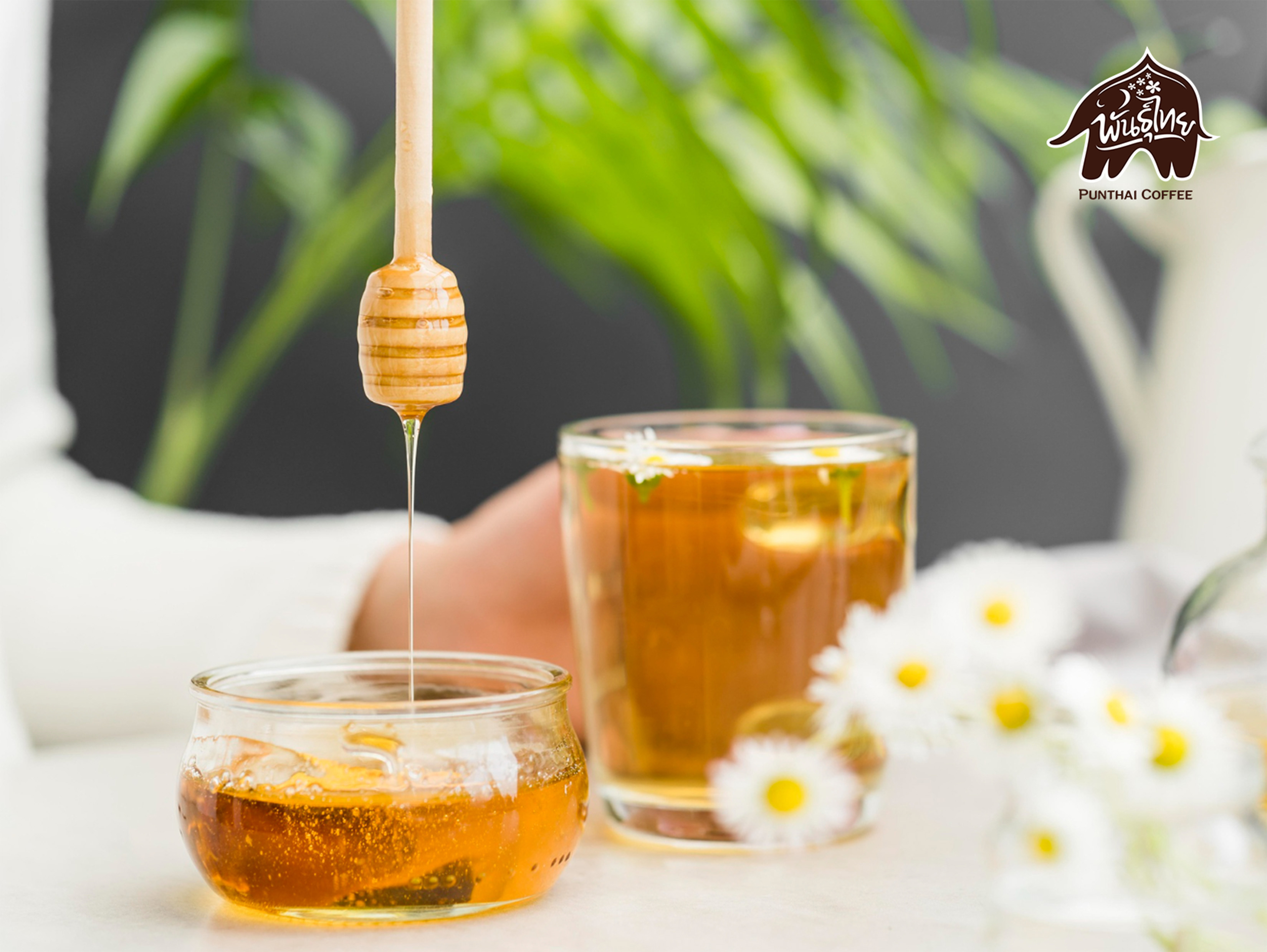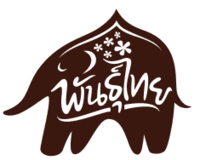
Unveiling the Remarkable Wildflower Honey Health Benefits
For those who enjoy sweetness but want to maintain their health by consuming natural sugar alternatives, replacing sugar with honey is a great option. In addition to having a sweeter and more delicious taste than regular sugar, honey also offers high nutritional value. Today, PunThai invites you to get to know honey, the differences between its types, and the benefits of wildflower honey, some of which you may not have known before. PunThai encourages you to consume Thai wildflower honey as a substitute for consuming sugar or artificial sweeteners.

Getting to Know Honey: Origin and Types of Honey
What is Honey?
Honey is one of nature's valuable products, created by the ingenious work of tiny bees and the richness of nature.
Honey originates from pure nectar gathered by worker bees from various types of flowers and plants, both wildflowers in natural forests and economically cultivated flowers. With the desire to create beautiful products inspired by these sources, bees diligently fly back and forth to collect nectar from a variety of flowers.
From this intricate blending process, two main types of honey are produced: forest honey, derived from flowers and plants in natural forests, and cultivated honey, which is carefully tended to by beekeepers. Despite their different origins, both types of honey should exhibit excellent quality characteristics, such as a perfectly sweet taste, a unique aroma, and an appealing color, reflecting their remarkable nutritional value and meticulous craftsmanship.
Origin of Different Types of Honey
Origins of honey
Honey can be divided into two main types based on its origin:
- Forest Honey: Derived from flowers and plants in natural forests.
- Cultivated Honey: Derived from beekeeping practices.
Types of Plants Bees Feed On
The chemical composition and distinctive aroma of honey vary depending on the types of flowers and plants that bees gather nectar from. For example:
- Honey from lychee flowers has a different aroma and taste from honey from sunflower blossoms.
- Honey from cherry blossoms has unique characteristics compared to regular forest honey.
Physical Characteristics
Each type of honey may have different colors, aromas, tastes, and thicknesses, depending on bee species, environmental conditions, and production processes.
Nutritional Properties
The chemical composition of different types of honey varies, including the amount of sugar, protein, minerals, and antioxidants.
This diversity allows honey to come in various colors and flavors worth trying, reflecting the richness of nature and the hard work of bees. It also provides consumers with the opportunity to choose honey that best suits their taste preferences.

Differences Between Each Type of Honey
1. Differences in Taste, Aroma, and Color
The main factors that cause differences in taste, aroma, and color between honeys or fresh honey are the types of flowers and plants that the bees gather nectar from.
The nectar from different types of flowers and plants contains different chemical compositions, resulting in the physical characteristics of honey varying widely. This includes hues ranging from light yellow to light brown, all the way to dark brown or burnt sugar.
Additionally, factors such as bee species, environmental conditions, and production processes also influence the characteristics of fresh honey. Therefore, the differences in taste, aroma, and color of honey depend primarily on the primary nectar sources gathered by the bees. This diversity adds to the charm of natural honey, offering a variety of flavors to enjoy.
2. Differences in Sugar Composition
The composition of sugars in honey affects the differences in its physical characteristics. The honey-making process starts with the collection of nectar from various flowers and plants. This nectar mainly consists of glucose and fructose. When worker bees bring the nectar into their honey stomachs, enzymes from their saliva help convert these sugars during flight. The bees then regurgitate this transformed nectar into the hive, where excess water is evaporated by fanning their wings, eventually resulting in mature honey.
However, if the honeycombs are harvested too quickly before sufficient water evaporation occurs, glucose and fructose may remain in different proportions, affecting the physical characteristics such as the crystallization of honey.
Generally, honey with higher fructose content tends to crystallize more easily than honey with higher glucose content. For example, honey from rubber tree gardens crystallizes more easily than honey from lychee flowers.
Moreover, the sugar composition also affects other properties of honey, such as sweetness level, freezing point, and physical stability.
Therefore, it can be said that differences in the proportions of various types of sugars, which result from differences in sources, production processes, and harvesting, are essential factors that lead to the distinct characteristics of each type of honey.

What is Wildflower Honey?
Wildflower Honey is a precious natural product that arises from the diligent work of bees combined with the richness of nature.
Inspired by the various wildflowers in lush green forests, from vibrant wildflowers to valuable herbal flowers, all are components that blend to give Wildflower Honey its perfectly sweet taste, distinctive aroma, and delightful color.
Wildflower Honey is a precious heritage from the northern forests of Thailand, on hillsides and vast, beautiful landscapes. With intricate mountain ranges and picturesque rice fields, it is a popular production area in regions such as Chiang Mai, Chiang Rai, Phrae, and Tak.
Each drop of Wildflower Honey is like a poem narrating the wonders of nature, reflecting the self-sufficient way of life and environmental conservation efforts of the Thai people. Therefore, Wildflower Honey is not just a sweet delicacy but also a symbol of the bond between the Thai people and the beautiful nature.
How Do Lychee Honey, Wildflower Honey, and Longan Honey Differ?
Lychee Honey
- Color: Light brown
- Aroma: Distinctive aroma
- Taste: Quite sweet
- Stability: Color and taste remain stable even when chilled
Longan Honey
- Color: Beautiful golden yellow
- Taste: Sweet and mellow
- Stability: May crystallize if subjected to cold temperatures
Wildflower Honey
- Color: Gradually darkens after harvesting, starting from light brownish-yellow
- Harvest Season: Typically harvested towards the end of the year (December - January)
- Stability: May crystallize if subjected to cold temperatures
In summary, these honeys differ primarily in color, aroma, taste, and response to cold temperatures, which result from variations in the plants they feed on and the harvesting periods. Each type has its own unique characteristics and flavor profiles.
These differences allow consumers to choose honey according to their preferences, experiencing the true charm of each type of honey derived from nature.

Share 12 Benefits of Wildflower Honey: Natural Properties from Nature's Honey
Wildflower Honey is one of nature's most beneficial products, offering numerous advantages in terms of nutrition and various special properties. Here are some:
1. Essential Source of Nutrients
Wildflower Honey comprises carbohydrates from natural sugars, providing the body with quick energy. It's rich in vitamins and minerals such as B vitamins, vitamin C, potassium, calcium, iron, and zinc. It also contains essential amino acids and enzymes vital for the body.
2. Antioxidant Properties
Wildflower Honey contains high levels of antioxidants such as flavonoids and phenolic acids. These compounds help combat free radicals and reduce the risk of chronic diseases.
3. Reduces Inflammation
With its natural antioxidants and anti-inflammatory properties like flavonoids, amino acids, and enzymes, Wildflower Honey helps inhibit inflammation. It alleviates pain, swelling, and redness.
4. Heals Burns
Wildflower Honey possesses antimicrobial properties, guarding against wound infection. It stimulates tissue regeneration, accelerating wound healing. It also absorbs yellow fluid and debris from wounds, acting as an outer layer dressing.
5. Soothes Coughs
Due to its sweetness and viscosity, Wildflower Honey lubricates the throat, soothing irritation from coughing. It has nerve-calming properties, relaxing respiratory muscle spasms and easing annoying coughs. It also dissolves mucus, facilitating easier expectoration and reducing cough-induced irritation.
6. Kills Respiratory Pathogens
With antimicrobial compounds like hydrogen peroxide, amino acids, and enzymes, Wildflower Honey combats various bacteria, fungi, and some viruses. It inhibits disease-causing pathogens in the respiratory tract, preventing their spread and reducing respiratory inflammation.
7. Reduces Heart Disease and Blood Pressure Risks
Wildflower Honey contains polyphenols and flavonoids that lower cholesterol and triglyceride levels in the bloodstream, reducing the risk of high blood lipid levels. This, in turn, lowers the risk of heart disease and blood vessel issues. It also dilates blood vessels, improving blood circulation. Its angiotensin-converting enzyme (ACE) inhibitors help maintain normal blood pressure, reducing the risk of hypertension.
8. Fights Bacteria, Fungi, and Some Viruses
The hydrogen peroxide levels in honey are sufficient to inhibit the growth of many types of microorganisms. These compounds result from the reaction of glucose oxidase enzymes present in honey with glucose and oxygen. Hydrogen peroxide can break down cell walls and DNA of bacteria and fungi. Additionally, honey contains organic acids like citric acid and gluconic acid, which enhance its antimicrobial properties.
These antimicrobial properties of honey are effective against various disease-causing microorganisms, including:
- Bacteria: Staphylococcus aureus, Bacillus, Salmonella, E. coli
- Fungi: Candida, Aspergillus
- Viruses: Influenza virus, Respiratory syncytial virus
Therefore, Wildflower Honey has beneficial properties in combating certain diseases, reducing the risk of infection, and can be used as a supportive treatment in some cases, particularly in wound healing and chronic wound care.
9. Benefits for Skin and Hair Health
- Wildflower Honey possesses properties that promote skin regeneration, keeping it moisturized, soft, and reducing scars.
- It nourishes hair, making it stronger, glossier, and helps in managing hair loss.
10. Helps Reduce Blood Fat and Cholesterol
Wildflower Honey also aids in reducing blood fat and cholesterol levels, crucial for consumers' health. Several research studies have demonstrated honey's ability to lower blood fat and cholesterol levels through the following mechanisms:
Reducing Fat
Honey contains antioxidants such as flavonoids and phenolic acids, which help reduce fat accumulation in tissues and blood vessels. It also increases levels of high-density lipoprotein (HDL), responsible for removing cholesterol from blood vessel walls.
Lowering Cholesterol
Honey inhibits the absorption of cholesterol from food in the small intestine, preventing its entry into the bloodstream. Some components in honey expedite the removal of excess cholesterol from the body. Moreover, honey contains antioxidants that reduce inflammation in blood vessel walls, a significant factor in heart and brain blood vessel diseases.
Therefore, consuming Wildflower Honey in moderation is a good choice for controlling blood fat and cholesterol levels, reducing the risk of heart and blood vessel diseases, as well as obesity and diabetes. This should be accompanied by a balanced diet and regular exercise.
11. Strengthens Immune System and Repairs Damaged Parts
Boosts Immune System
Honey is rich in antioxidants such as flavonoids, phenolic acids, and enzymes that bolster the body's immune system. It has antiviral, anti-inflammatory, and antibacterial properties, which help prevent infections. Honey also increases the number and enhances the functioning of white blood cells, crucial for fighting foreign invaders.
Repairs Damaged Parts
Honey contains essential vitamins and minerals such as vitamin C, biotin, potassium, and zinc, necessary for cell regeneration and repair. It has compounds that stimulate the production of new collagen, vital for repairing skin, tendons, and bones. It accelerates wound healing, especially honey with lemon and herbal honey.
12. Aids in Digestive System Function and Nutrient Absorption
In addition to its benefits in bolstering the immune system and repairing the body, Wildflower Honey also has favorable effects on the body's digestion and nutrient absorption:
Improves Digestive System and Nutrient Absorption
Honey contains enzymes that aid in the digestion of carbohydrates, proteins, and fats, such as diastase, alpha-glucosidase, and invertase. It has amino acids and organic acids that stimulate the production of digestive juices in the body, like hydrochloric acid, pepsin, and other enzymes. It helps reduce bloating and flatulence by promoting digestion and elimination from the body.
Enhances Nutrient Absorption
Wildflower Honey is rich in prebiotics and compounds known as bioactives that promote a healthy balance of gut bacteria, enhancing nutrient absorption efficiency. It has small molecules that can easily pass through intestinal walls, facilitating better absorption of nutrients. Its complex of nutrients, including vitamins and minerals, ensures comprehensive nutrient absorption.
In conclusion, Wildflower Honey offers multifaceted benefits, including immune support, wound healing, and improved digestion, making it a valuable addition to one's diet and skincare routine.

With these properties, consuming wildflower honey, which has diverse nutritional value, helps to strengthen and nourish our bodies because sugar is poison. Substituting honey for sugar or synthetic sweeteners is suitable for health-conscious individuals. Beyond the benefits of wildflower honey, its unexpected advantages include using it to enhance the flavor of food and beverages, a practice common in restaurants and cafes. In PunThai cafe, we use natural wildflower honey to add a rounded sweetness to beverages without overwhelming the palate. Moreover, it offers additional benefits. Read more about these health benefits on PunThai blog and don't forget to order popular PunThai beverages!
Reference:
- ความแตกต่างของน้ำผึ้ง และลักษณะของน้ำผึ้งที่ดี - สุวรรณฟาร์ม
- น้ำผึ้งดอกลำไย น้ำผึ้งดอกไม้ป่า และ น้ำผึ้งดอกลิ้นจี่ต่างกันอย่างไร ? - สุวรรณฟาร์มผึ้ง



